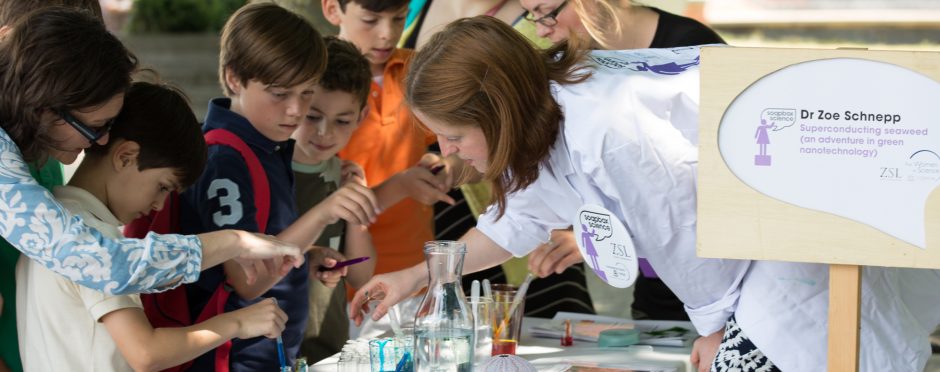 Prof Julie Williams (JW) is the Chief Scientific Advisor to the Welsh Government, and one of our speakers at our Soapbox Science (SS) Swansea event this Saturday. Before the event, she answers a short set of questions, which hopefully provide some insights into her career path, motivations, and research area. Do join Julie on the 5th of July, 11-3, on the expanse of Swansea Bay (next to the 360 Beach and Watersports centre and café) and hear her talk on what genes can tell us about dementia.
Prof Julie Williams (JW) is the Chief Scientific Advisor to the Welsh Government, and one of our speakers at our Soapbox Science (SS) Swansea event this Saturday. Before the event, she answers a short set of questions, which hopefully provide some insights into her career path, motivations, and research area. Do join Julie on the 5th of July, 11-3, on the expanse of Swansea Bay (next to the 360 Beach and Watersports centre and café) and hear her talk on what genes can tell us about dementia.
SS: Julie, it is a great honour to have you on our soapbox for the first Soapbox Science event in Swansea. The aim of this Q&A is to get our readers to know a little bit about you. So, to start with, maybe you can tell us how you got to your current position?
JW: I studied psychology at degree level and then used the skills I had to practical and potentially life-saving use while working for chemical giant ICI, designing their instrument panels in an attempt to lessen the margin for employee error – the result of which could easily prove to have fatal consequences.
After going on to do a PhD looking at, amongst other things, the effects of stress and noise in work-base situations, I took time out to start a family. When my daughters were one and four, I moved back into academia and renewed my career in research, but I found it was really difficult to get back in.
It was not just because I had my hands full with the children either – there are plenty of families out there who have to cope with the same – I had to get my foot back in the door with a part-time position at Cardiff’s University of Wales College of Medicine at a lower grade.
Luckily, the study of genetics was having a revolution of sorts back in the early ’90s and it was becoming feasible to do things you couldn’t have done five or 10 years previously, like looking at genetic variation and its relationship with disease. Having started working on the likes of schizophrenia for a number of years I moved onto Alzheimer’s, a field of research which was a little more developed. I was fascinated by what genetics could do in identifying at a finite, molecular level what was going on with this disease.
In 2008 I became Chief Scientific Advisor to Alzheimer’s Research UK. I have also advised UK and Welsh Governments on dementia policy. Previously Dean of Research at the School of Medicine, Cardiff University, I was appointed Chief Scientific Advisor to the Welsh Government in September 2013.
SS: What, or who, inspired you to get a career in science?
JW: As a child I had this burning interest in things that weren’t fully understood and the idea of having insight into something no one else knew about really intrigued me, so I bought this little pamphlet on Faraday from a branch of WH Smith one day – which, I must stress, I didn’t fully understand – and just thought it was neat. It showed all his notes and brought the process of what he’d managed to do to life, I was just in awe of it.
Then there was this great documentary series that used to run on the BBC called The Ascent of Man which was presented by the historian Jacob Bronowski and traced the development of human society through its understanding of science.
SS: What is the most fascinating aspect of your research?
JW: In this job excitement comes along once in a blue moon because, more often than not, your first reaction each time you get an interesting development is to immediately go, “Uh-oh, better recheck my findings to check we’ve not done something wrong.’ It’s only when other research teams start producing the same results that you sort of allow yourself a quiet sense of satisfaction, even then though you’re talking months and months down the line – it’s hardly a punch-the-air Eureka moment.
But when I was just about to give a talk about our findings at a 2009 conference in Vienna was one of those rare moments when I suddenly felt we were on the cusp of something new, since another research team also had a paper which boasted similar findings to ours.
In the space of one short day we realised that we’d highlighted three new genes for Alzheimer’s. That’s more than had been accomplished in the previous 17 years.
I’ll never forget that.
SS: What attracted you to Soapbox Science?
JW: The opportunity to share experiences and communicate with people about science.
SS: And if you had to sum up in one word your expectations for the day?
JW: Enthusiasm.
SS: You have a magic wand, you can change one thing about the scientific culture right now. What would it be?
JW: We need a more flexible and supportive structure to underpin career development within science.
SS: Finally, what would be your top recommendation to a female PhD student considering pursuing a career in academia?
JW: Be persistent – if you think you can make a difference just go for it. You don’t have to be perfect to succeed.









